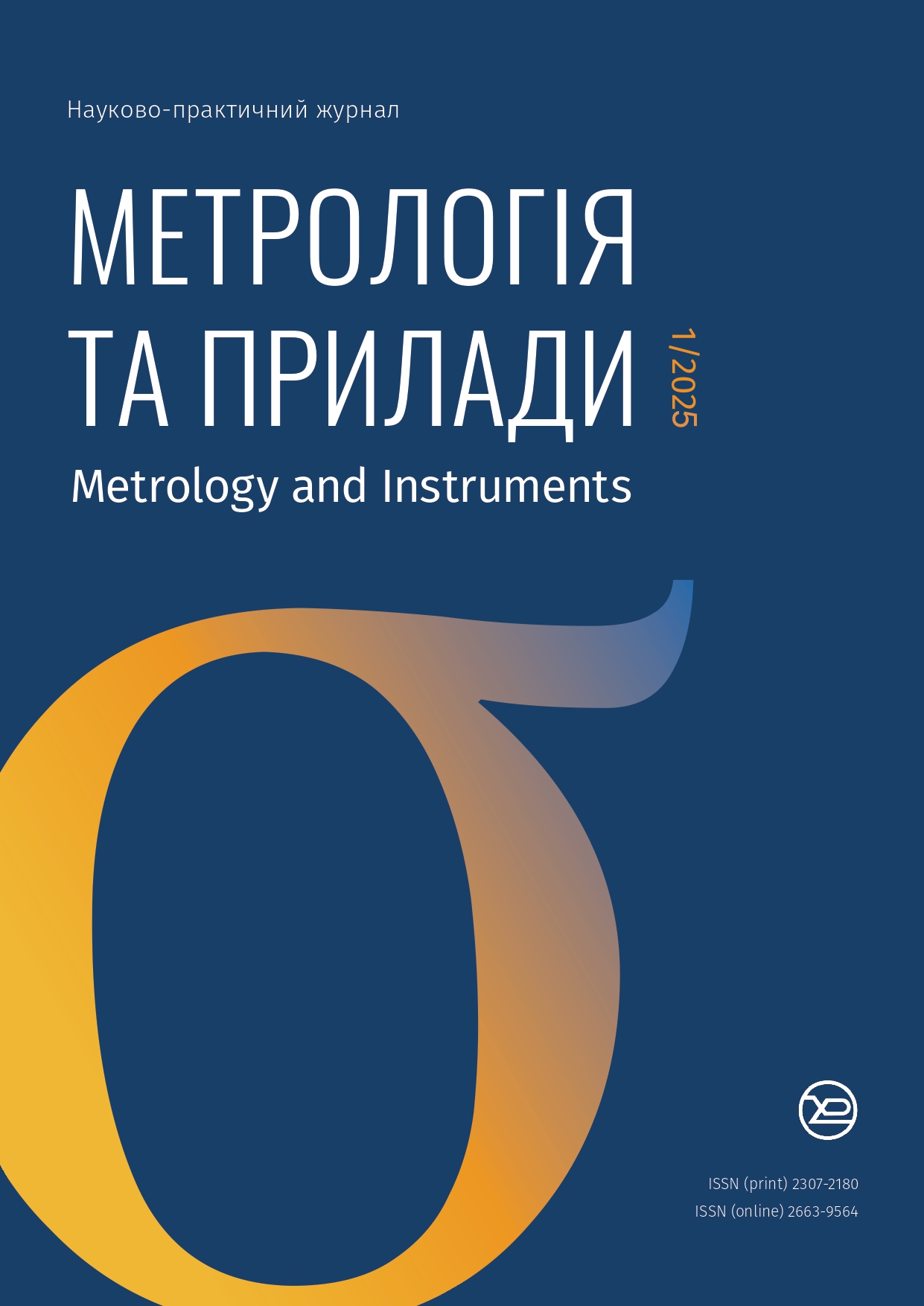Атомно-абсорбційне визначення міді в мікроводорості Dunaliella Viridis та подальше її використання як лікувального засобу
DOI:
https://doi.org/10.30837/2663-9564.2025.1.09Ключові слова:
мікроводорості, атомно-абсорбційна спектрометрія, мідь, пробопідготовка, ультразвукова обробка, біологічні зразки, метрологічні характеристикиАнотація
Атомно-абсорбційним методом було визначено вміст міді в біомасі водорості Dunaliella viridis та печінці самців щурів. Використовуючи ультразвукову обробку зразків досягалась повнота вилучення міді та гомогенність зразків. Було досліджено вплив міді на біологічні зразки. Отримані результати свідчать про те, що додавання іонів міді до біомаси мікроводоростей супроводжується утворенням різних структурно-функціональних комплексів, які можуть мати різну антибактеріальну активність, а наявність антибактеріальних ефектів зумовлена не лише дією іонів міді. Це було підтверджено даними про наявність антибактеріальної дії гомогетанів клітин мікроводоростей. Показано, що йони міді мають здатність пригнічувати ріст S. aureus 124 та P. Aeruginosa 18. Ефективність пригнічення росту залежить від концентрації, і ця залежність має насичувальний характер. P. aeruginosa 18 мала меншу чутливість порівняно з S. aureus 124 за відносно низьких концентрацій, а при досягненні високих концентрацій (7-20 г/л) ефективність пригнічення росту йонами міді була однаковою для обох штамів. Біомаса водорості може бути використана для виготовлення харчових добавок, що компенсують дефіцит міді та ß– каротину в організмі
Посилання
Yurchenko O. I., Chernozhuk T.V., Nikolenko M.V., Baklanov O.M., Kravchenko, O. A.. Atomic absorption determination of copper and zinc in pharmaceutical preparations. Voprosy Khimii I Khimicheskoi Tekhnologii. 2024, 1, 115–121. URL: https://doi.org/10.32434/0321-4095-2024-152-1-115-121
Bozhkov A. I., Sidorov V. I., Alboqai O. K., Akzhyhitov R. A., Kurguzova N. I., Malyshev A. B., Albegai M. A. Y., Gromovoi T. Yu. The role of metallothioneins in the formation of hierarchical mechanisms of resistance to toxic compounds in young and old animals on the example of copper sulfate. Translational Medicine of Aging. 2021, 5, 62–74. URL: https://doi.org/10.1016/j.tma.2021.11.001
Urso E., Maffia M. Behind the Link between Copper and Angiogenesis: Established Mechanisms and an Overview on the Role of Vascular Copper Transport Systems. Journal of Vascular Research. 2015, 52(3), 172–196. URL:https://doi.org/10.1159/000438485
Garber K. Targeting copper to treat breast cancer. Science. 2015, 349(6244), 128–129. URL: https://doi.org/10.1126/science.349.6244.128
White A. R., Kanninen K. M., Crouch P. J. Editorial: Metals and neurodegeneration: restoring the balance. Frontiers in Aging Neuroscience. 2015, 7. URL:https://doi.org/10.3389/fnagi.2015.00127
Orta-Rivera A. M., Meléndez-Contés Y., Medina-Berríos N., Gómez-Cardona A. M., Ramos-Rodríguez A., Tinoco A. D. Copper-Based Antibiotic Strategies: Exploring Applications in the Hospital Setting and the Targeting of Cu Regulatory Pathways and Current Drug Design Trends. Inorganics. 2023, 11(6), 252. URL:https://doi.org/10.3390/inorganics11060252
Michels H. T., Noyce J. O., Keevil C. W. Effects of temperature and humidity on the efficacy of methicillin-resistantStaphylococcus aureuschallenged antimicrobial materials containing silver and copper. Letters in Applied Microbiology. 2009, 49(2), 191–195. URL:https://doi.org/10.1111/j.1472-765x.2009.02637.x
Bozhkov A.I., Bobkov V.V., Osolodchenko T.P., Yurchenko O.I., Ganin V.Y., Ponomarenko S.V. The antibacterial activity of the copper for Staphylococcus aureus 124 and Pseudomonas aeruginosa 18 depends on its state: metalized, chelated and ionic. 2024, 10(20), 2405-8440. URL:https://doi.org/10.1016/j.heliyon.2024.e39098
Kovaleva M. K., Menzyanova N. G., Jain A., Yadav A., Flora S., Bozhkov A. I. Effect of Hormesis in Dunaliella viridis Teodor. (Chlorophyta) Under the Influence of Copper Sulfate. International Journal on Algae. 2012, 14(1), 44–61. URL:https://doi.org/10.1615/interjalgae.v14.i1.40.
Wohlleben W., Mast Y., Stegmann E., Ziemert,N. Antibiotic drug discovery. Microbial Biotechnology. 2016, 9(5), 541–548. URL:https://doi.org/10.1111/1751-7915.12388
Godoy-Gallardo M., Eckhard U., Delgado L. M., de Roo Puente Y. J. D., Hoyos-Noguйs M., Gil F. J., Perez R. A. Antibacterial approaches in tissue engineering using metal ions and nanoparticles: From mechanisms to applications. Bioactive Materials. 2021, 6(12), 4470–4490. URL:https://doi.org/10.1016/j.bioactmat.2021.04.033
Lavrynenko O., Zahornyi M., Vember V. Photocatalytic destruction of organic dyes by titanium dioxide particles doped with gold. Proceedings of the NTUU “Igor Sikorsky KPI”. Series: Chemical Engineering, Ecology and Resource Saving. 2023, 4, 69–79. URL:https://doi.org/10.20535/2617-9741.4.2023.294330
Karasek F.W., Clement R.E. Basic Gas Chromatography-Mass Spectrometry: Principles and Techniques. 1988
Haiovyi S., Bozhkov A. Hormetic effect on the toxic action of copper ions depends on the tissue distribution of copper ions. Grail of Science. 2023, (31), 157–162. URL:https://doi.org/10.36074/grail-of-science.15.09.2023.26
Bozhkov A. I., Bozhkov A. A., Ponomarenko I. E., Kurguzova N. I., Akzhyhitov R. A., Goltvyanskii A. V., Klimova E. M., Shapovalov S. O. Elimination of the toxic effect of copper sulfate is accompanied by the normalization of liver function in fibrosis. Regulatory Mechanisms in Biosystems. 2021, 12(4), 655–663. URL: https://doi.org/10.15421/022190
Bryantseva Yu.V. Diversity and distribution of dinoflagellates in water bodies of Ukraine (critical and systematic revision). Algologia. 2023, 33(2), 98–126. URL: https://doi.org/10.15407/alg33.02.098
Cavalletti, E., Romano, G., Palma Esposito, F., Barra, L., Chiaiese, P., Balzano, S., & Sardo, A. Copper Effect on Microalgae: Toxicity and Bioremediation Strategies. Toxics. 2022, 10(9), 527. URL:https://doi.org/10.3390/toxics10090527.
Salah I., Parkin I. P., Allan E. Copper as an antimicrobial agent: recent advances. RSC Advances. 2021, 11(30), 18179–18186. URL:https://doi.org/10.1039/d1ra02149d.
Arendsen L. P., Thakar R., Sultan, A. H. The Use of Copper as an Antimicrobial Agent in Health Care, Including Obstetrics and Gynecology. Clinical Microbiology Reviews. 2019, 32(4). URL:https://doi.org/10.1128/cmr.00125-18.
Noyce J. O., Michels H., Keevil C. W. Potential use of copper surfaces to reduce survival of epidemic meticillin-resistant Staphylococcus aureus in the healthcare environment. The Journal of Hospital Infection. 2006, 63(3), 289–297. URL:https://doi.org/10.1016/j.jhin.2005.12.008.
Giachino A., Waldron K. J. Copper tolerance in bacteria requires the activation of multiple accessory pathways. Molecular Microbiology. 2020, 114(3), 377–390. URL:https://doi.org/10.1111/mmi.14522.




